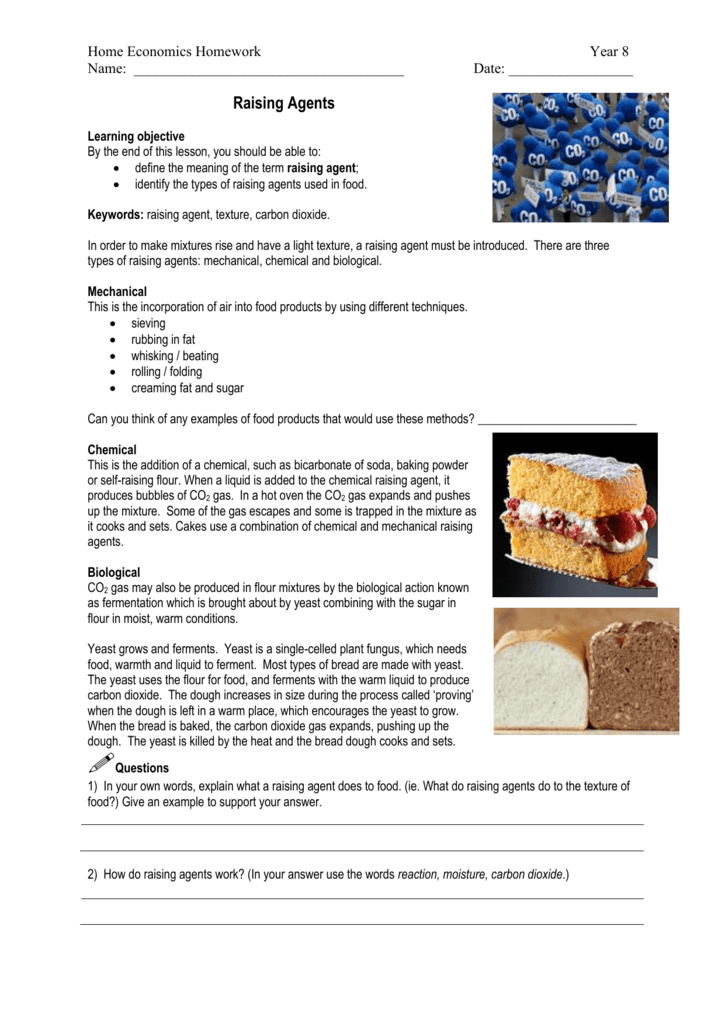
Be careful not to use too much bicarbonate of soda as foods can end up tasting soapy. TYPES OF RAISING AGENTS 1.

While most of us are familiar with baking powder there are many other chemical raising agents used to make bread cake and pastries.
Different types of raising agents. Types of raising agents. Methods of aeration or raising agents Biological Yeast Chemical Baking powder Mechanical Whiskingbeating Lamination Foldingrolling YEAST. Given the right conditions of warmth liquid and food yeast will feed on sugar and produce carbon dioxide as a by-product.
Raising agents Four main raising agents are used in cooking. Air - egg whites beating creaming rubbing in Steam - profiteroleschoux pastry Yorkshire pudding Carbon dioxide - yeast fermentation baking powder self raising flour Chemicals - bicarbonate of soda baking powder How do chemical raising agents work. There are 3 main chemical raising agents.
List of five common raising agents used in bakery- 1. Bicarbonate of Soda 3. Cream of Tartar 4.
Bicarbonate of soda aka baking soda and baking powder are not the same thing and are not interchangeable in a recipe. They work in different ways and the recipes will be tailored to suit the recommended raising agent. Different types of raising agents Raising agents are added to foods such as cakes cookies biscuits etc to make them rise during production helps to give them their texture or crust.
There are different types of raising agent and each raising is slightly different and has a specific role. What are the two types of raising agents. Yeast and baking soda or baking powder.
A mercantile agent is an agent who has authority to sell goods or buy goods or raise money on the security of goods. The various kinds of mercantile agents are. A factor is one to whom goods are entrusted for sale.
He enjoys extensive powers. What are the different types of raising agents. Browse the articles related different types of raising agents.
While most of us are familiar with baking powder there are many other chemical raising agents used to make bread cake and pastries. Also known as leavens these different forms of raising agents release carbon dioxide during the baking process causing bubbles and foaming to occur. This is what gives baked goods their light fluffy texture.
Other chemical raising agents include self-raising flour and bicarbonate of soda. Self-raising flour has baking powder added to it already. Bicarbonate of soda can be used if the other ingredients contain an acid such as buttermilk lemon juice or vinegar.
Be careful not to use too much bicarbonate of soda as foods can end up tasting soapy. Raising Agent 450i Composition. There are many types of raising agents with different groups and properties.
Sodium bicarbonate or baking soda E500i is related to a group of acidity regulators or anti-caking agents. However raising agent 450 belongs to the emulsifier range. RAISING AGENT A raising agent or leavening agent is any one of a number of substances used in dough and batters that causes a foaming action that lightens and softens the finished product.
Formation of carbon dioxide is induced by chemical agents reacting with moisture heat acidity or other triggers. TYPES OF RAISING AGENTS 1. All the latest news related 3 types of raising agents are here.
Jul 2 2020 - Different Types Of Raising Agents Raising agents help cakes and biscuits rise give them their texture or crust and each raising agent is slightly different and has a specific role. Lots of people ask.